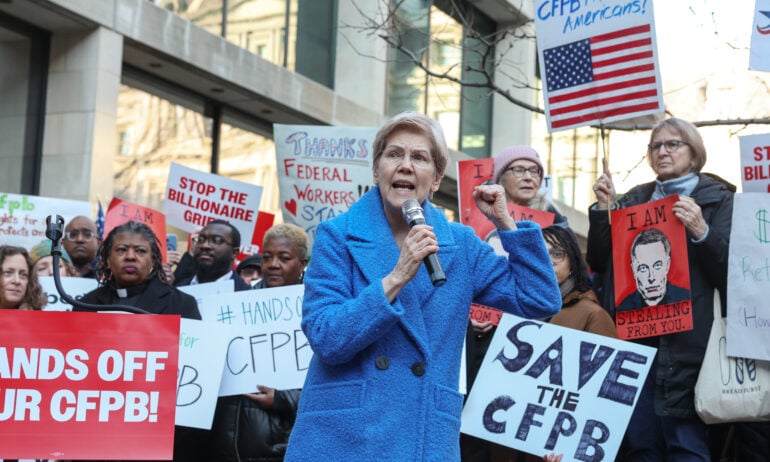R.I.P. CFPB? What’s At Stake If the Watchdog Agency Goes Dark
Advocates fear consumers could be left to fend for themselves in a complicated financial marketplace.

Many, or all, of the products featured on this page are from our advertising partners who compensate us when you take certain actions on our website or click to take an action on their website. However, this does not influence our evaluations. Our opinions are our own. Here is a list of our partners and here's how we make money.
Under new leadership, the Consumer Financial Protection Bureau has rolled back previous work it did under the Biden administration, including dropping numerous enforcement actions against financial services companies, halting investigations and promising to revoke at least one rule it set to regulate new financial products.
Meanwhile, a federal judge is considering whether to issue a preliminary injunction that would block efforts by the Trump administration to dismantle the independent agency by eliminating nearly all of its staff. The lawsuit was brought by the union representing CFPB workers.
The article below was originally published Feb. 20, after newly installed CFPB leaders halted the agency’s work. The latest updates on changes to the CFPB under the Trump administration can be found here.
Stalled lawsuits. Halted supervision and oversight. Suspended workforce. The Consumer Financial Protection Bureau is in the midst of a complete overhaul that could cripple its ability to act as the consumer finance watchdog it was designed to be.
While the fate of the CFPB remains unclear, recent actions by the Trump administration indicate that, if it survives, it’ll be a much smaller and weaker agency than before. Advocates and public policy experts fear that without the bureau, consumers could be left to fend for themselves in a complicated and ever-evolving financial marketplace where unfair and deceptive practices go unchecked.
“We think the activities of the CFPB are broadly popular with the American people and it’s hard to see how we can just leave consumers completely unprotected in the very large financial services economy that we have,” Chuck Bell, program director for advocacy at Consumer Reports, told NerdWallet. “And I think that any government that doesn’t try to protect customers on some of these issues is going to have a lot to answer for.”
The CFPB was created in 2010 in response to the financial crisis that triggered the Great Recession. Since Congress established the bureau, it would take an act of Congress to fully dissolve it. Without that, the administration’s efforts to prevent it from fulfilling its Congressional mandate could be deemed illegal. Lawsuits like the one filed by the National Treasury Employees Union are an attempt to use the courts to thwart those efforts.
Sen. Elizabeth Warren, the primary architect behind the CFPB’s creation, has been vocal in its defense. “I fought to create the Consumer Financial Protection Bureau for the same reason I’m fighting to defend it: big banks shouldn’t be able to cheat people,” she posted on X this week.
What if the CFPB goes away?
Before the CFPB, federal consumer protection laws were enforced by a variety of federal regulators — an “unusual patchwork system” that proved not only inefficient but ineffective, says Mallory SoRelle, assistant professor at the Sanford School of Public Policy at Duke University and author of the 2020 book “Democracy Declined — The Failed Politics of Consumer Financial Protection.”
Those existing regulators were created to look out for banks’ interests, so the added consumer protection mandates created tension in their jobs, SoRelle says. On top of that, spreading out consumer protection across multiple agencies required a level of coordination that was hard to achieve.
News moves fast. Stay ahead of how it could impact your money.
Interest rates, inflation, natural disasters — get notified when breaking news could affect your finances, and get expert insights to help you plan your next move.

“What ended up happening was really weak consumer financial protections,” SoRelle says. “That led in no small part to the financial crisis.”
The CFPB was set up to be a centralized rulemaker. Multiple regulators still coordinate, but now there’s an obvious, expert authority with a singular goal to protect consumers in the financial space. Congress further insulated the bureau from political pressure by funding it through the Federal Reserve instead of Congressional appropriation — an unusual arrangement that the Supreme Court upheld in 2024.
As a result, the CFPB is more efficient than the previous consumer protection system, SoRelle argues. And that’s made it an effective watchdog. Since it was established, and especially under the Biden administration, the bureau has reformed many aspects of the consumer financial space, penalized companies that broke the law and refunded billions of dollars to consumers who lost money as a result of unfair or illegal practices.
“The idea that it’s duplicative or inefficient is simply not true,” SoRelle says, adding that a diminished CFPB could bring back the environment that existed before the agency was created.
Active and robust consumer protection
The CFPB operates in a consumer finance marketplace that includes not only traditional banking and loan products — including those for major purchases like cars or houses — but also credit reporting that can influence a person’s financial opportunities and technology that’s never been seen before.
As a result, the CFPB has been active on many fronts. It supervises and investigates companies, pursues consumer complaints, makes and enforces rules and studies trends and common practices in the industry, among other activities.
SoRelle says without a functioning CFPB, consumers risk losing “active and robust” consumer protection. The impact of its enforcement efforts alone have been substantial. Since its inception, the CFPB netted consumers $19 billion in refunds, principal reductions, canceled debts and other consumer relief, while imposing $5 billion in civil penalties on companies and individuals who broke consumer protection laws.
Some examples of those enforcement actions include:
Keeping credit bureaus in check. The CFPB protects consumers from negligence that could harm their credit scores. For example, in January 2025, the CFPB took separate legal actions against Experian and Equifax for not properly investigating disputes and removing incorrect information from consumers’ credit reports. The bureau filed a lawsuit against Experian. And Equifax was ordered to pay $15 million in civil penalties.
Penalizing banks for creating fake accounts. Wells Fargo paid the CFPB a $100 million initial fine in 2016 for opening about 1.5 million deposit accounts without customers’ consent. These fake accounts helped bankers meet aggressive sales goals and resulted in charging fees to customers who were unaware of these accounts. The CFPB later penalized Bank of America in 2023 and Fifth Third Bank in 2024 for also opening fake bank accounts or credit cards and charging customers fees.
Rooting out harmful private student loan lenders and federal servicers. In 2024, CFPB banned Navient from federal student loan servicing and ordered it to pay a $120 million settlement, including $100 million in redress to borrowers who were harmed by its “wide-ranging student lending failures,” including illegally or inappropriately steering borrowers toward costly forbearance instead of income-driven repayment plans. Some private Navient loan borrowers also had the chance to apply for private student loan forgiveness — a rare opportunity.
Investigating discriminatory lending practices. CFPB files lawsuits against mortgage lenders that violate fair lending laws. Most recently, the CFPB has sued Rocket Homes for alleged home buyer steering and Vanderbilt Mortgage & Finance for allegedly failing to properly consider borrowers' ability to repay loans. It recently proposed a settlement with Fairway Mortgage over redlining.
Stopping wrongful auto repossessions. In those cases, the repossessions occurred after borrowers had made timely payments or secured loan extensions. In one related case, the CFPB sued USASF Servicing for using kill switches to illegally disable vehicles, ending with a $42 million penalty against USASF.
Ordering refunds for defrauded customers. The CFPB has gone after owners of digital payment systems that didn’t sufficiently safeguard customers against fraud. In January, it ordered Block, which owns Cash App, to pay refunds and penalties of up to $175 million for maintaining poor security protocols that hurt its users. In December, it sued the operator of Zelle and three of its owners — Bank of America, JPMorgan Chase and Wells Fargo — alleging that its failures led to $870 million in losses for customers.
What happens to pending cases, rules?
The Zelle lawsuit is one example of CFPB actions that are in limbo under the new administration. The current order to stop work at the bureau has prevented attorneys from arguing its cases or defending its rulemaking in courts. Another pending legal matter involves a lawsuit that seeks to stop a CFPB rule to reduce credit card late fees. It was one of several rules designed to eliminate junk fees that consumers are forced to pay across a variety of services.
“Consumers could lose hundreds of millions of dollars in restitution and relief if the CFPB does not pursue those lawsuits and the cases to defend its regulations,” Bell says.
Similar uncertainty surrounds rules that have been finalized by the CFPB but haven’t yet taken effect. Vought’s stop-work order at the bureau suspended the effective dates of those rules, including one that would remove medical debt from credit reports and another that would reduce overdraft fees charged by major banks. Separately, a resolution introduced Feb. 13 in the House Financial Services Committee seeks to roll back the overdraft rule.
Highly visible consumer advocate
In addition to enforcement and rulemaking, SoRelle says the CFPB also serves as a highly visible consumer advocate, demonstrating the link between personal finances and government accountability that helps consumers know there’s someone in their corner.
For example, the Student Borrower Protection Center credits the CFPB with supporting U.S. Department of Education efforts to cancel $188.8 billion of student debt for 5.3 million borrowers during the Biden administration. It’s worth noting the administration has threatened to dismantle the Education Department, as well.
It’s common for consumers to encounter the CFPB in paperwork they receive when they take on a new mortgage or Google search results while they’re researching answers to financial questions.
Additionally, the CFPB gives consumers a place to submit complaints about banks, credit card companies, lenders, debt collectors and others. It receives roughly 25,000 per week, according to its website. The bureau shares each complaint with the company named by the consumer (or with another federal agency if the complaint falls outside the CFPB’s scope) and calls on the company to respond.
The bureau maintains a public complaint database, which helps consumers get information about institutions or products and makes it clear which tend to cause the most trouble. In all, the bureau has received more than 6.8 million consumer complaints, with most related to credit reporting. Other common topics of complaint include debt collection, credit cards, checking or savings accounts, mortgages and student loans.
“They have made the complaint-making process much easier than it used to be,” SoRelle says. “They’ve managed to get both financial and nonfinancial remedies much more frequently.”
If not the CFPB, then who?
If the CFPB is eliminated or effectively neutralized over the next four years, it could leave a gap in monitoring the consumer financial industry.
“Presumably regulatory oversight would be returned to other regulators or handed over to the state,” SoRelle says. But it’s not clear what happens to the rules it made. “Do other agencies enforce them? Do they get wiped off the books?”
That uncertainty is being felt in pockets of the financial services industry, as well. Some industry leaders have chafed under its supervision, decrying its heavy-handed rulemaking and enforcement. Others, including some bankers, fintech leaders and mortgage lenders, support its role as a centralized regulator, telling news reporters recently that getting rid of it entirely would be a mistake.
“When you tear it all down, you potentially lose what had been good regulatory policy,” Phil Goldfeder, the chief executive of the American Fintech Council, told Politico’s Morning Money. “When operated correctly and bereft of ideological drive, the CFPB could be a valuable tool for responsible regulation.”
Additionally, the CFPB has a leading role in monitoring a number of new financial products or technologies that could lose oversight if the bureau were shuttered. And that could have implications for consumers that use them.
For example, data suggests that people who use buy now, pay later loans are more financially vulnerable than the general population, according to studies by the CFPB and Federal Bank of New York. They have higher credit card balances, take out more unsecured loans and may not be able to get approved for credit elsewhere. In May 2024 the CFPB introduced new protections for users of the popular BNPL products.
The CFPB also started to regulate earned-wage access products, which serve the same purpose as payday loans, as well as peer-to-peer payment systems — including the kind Elon Musk hopes to integrate with X. As lawsuits filed by the CFPB have indicated, those payment systems have exposed many customers to fraud.
“The biggest thing is nobody quite knows what happens next,” SoRelle says.
NerdWallet writers Anna Helhoski, Amanda Barroso, Lauren Schwahn, Sara Rathner, Jackie Veling, Eliza Haverstock, Shannon Bradley, Spencer Tierney and Kate Wood contributed to this report.
(Photo by Jemal Countess/Getty Images for MoveOn)

